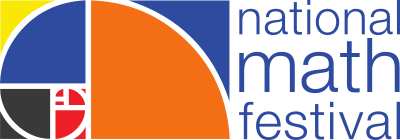2019 Festival: Coloring and Curvahedra
As part of the 2019 Festival, the Mathematical Sciences Research Institute (opens new window) (MSRI) will host the Mathical Reading Room & Coloring Corner, where Festival attendees can enjoy some quiet time coloring and sharing their mathematical art. Among the coloring creations available will be works by Dr. Edmund Harriss (University of Arkansas), a “mathematician, teacher, artist and maker, driven by a passion to communicate the beauty and utility of mathematical thinking.” Dr. Harriss shared the following guest post with us about exploring mathematical ideas through play!
Colouring and Curvahedra with Edmund Harriss
As the coauthor of two colouring books, I am asked surprisingly often “Am I doing this right?” Perhaps this is because the images in those books all come from mathematics, a place known more for its worthy learning than its play. Yet I have to admit to a little frustration. These are colouring pages. Is there a wrong way to do them?
We are overtrained that mathematics has correct answers. While there is some truth to that, especially in school math, it is not the whole picture. It is certainly not my experience. In fact for me, playing and exploring around mathematical ideas is a far more fundamental part of doing mathematics. We can create a space to experience and play with mathematical ideas alongside the more technical pedagogy.
One great strength of experience and play is that they lose some of the limits on the technical notions. They can break down barriers and open up areas that otherwise require a long technical preparation. Those two colouring books I mentioned have images drawing on mathematics from all levels up to current research topics. Children and adults will have a chance to colour several images from the colouring books at the May 4th National Math Festival (opens new window).
Outside of the images explored in the two colouring books, one particular topic I find fascinating for play is the notion of a surface, such as the outside of a ball or the surface of the ocean. These have beautiful properties that can be studied with the ideas of differential geometry, but that is generally only taught to math majors in their final year of undergraduate or the first year of grad school.

I wanted to bring this material out of the ivory tower. So I started from the ways that I and others play with the ideas: cutting and connecting sheets of paper. With that in mind I came up with a system of branched pieces that could connect together, creating smooth surfaces. As these surfaces would often be curved and had some similarities to polyhedra (a solid with many flat faces) they are called “Curvahedra (opens new window).”
These pieces hook together in any way you wish. For example, three of the five branch pieces make a loop like this:
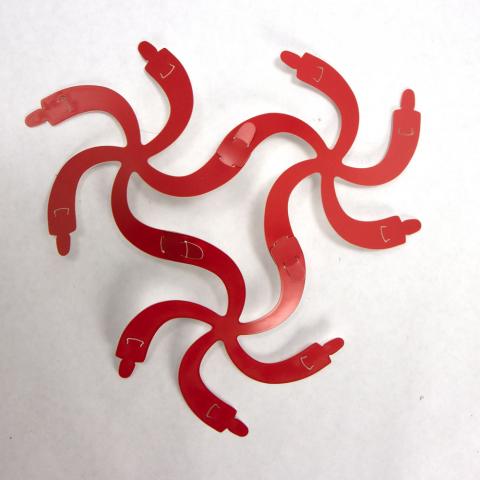
This is a sort of triangle. Looking at the corners, we see that the angles are each 72 degrees (1/5 of 360). Yet three times 72 is 216, not the 180 we would expect from a regular triangle. Yet this is also clearly not a regular flat triangle. Putting more together we get something that clearly curves as it closes up into a sphere.
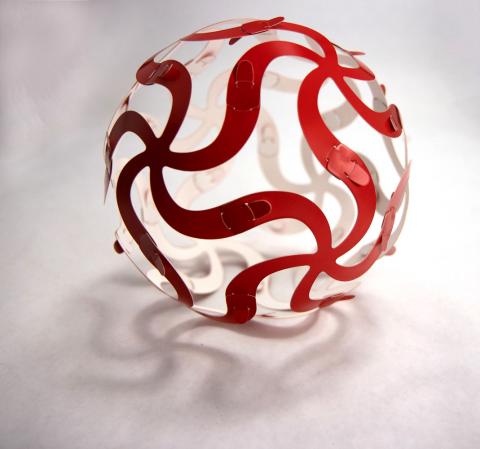
The relationship between the angle one turns going round a loop and the way the surface curves is a beautiful result called the Gauss Bonnet Theorem. In technical language, it gives an equation relating these two quantities, yet the fundamental idea can be understood by playing with Curvahedra. Even the description above is more than needed. Here are the explorations of many people at a recent event at Imperial College in London:
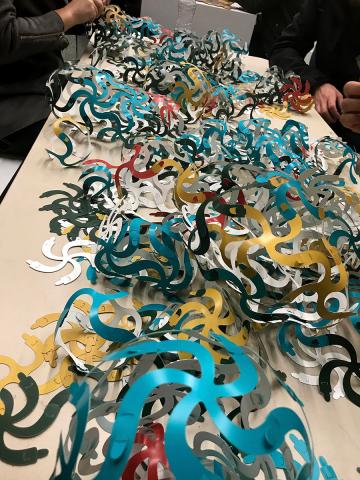
You can build larger models exploring deeper into the mathematics of topics including minimal surfaces:
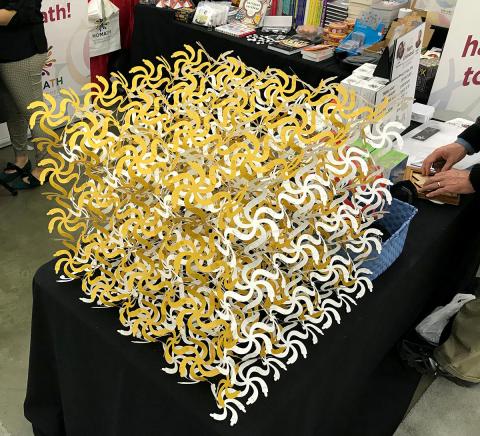
So playing with math can break down barriers to give some sense of the deepest material, at the same time as building the joy and resilience needed when the material gets hard and the meaning of the symbols unclear.
Explore the 2019 Festival: Mathical Reading Room & Coloring Corner
Dr. Edmund Harriss is Clinical Assistant Professor in Mathematics at the University of Arkansas. He is the author with Alex Bellos of two coloring books – published on both sides of the Atlantic: Patterns of the Universe (opens new window) and Visions of the Universe (opens new window).

